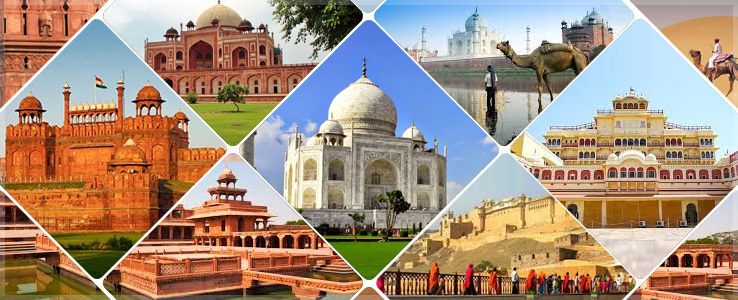
Introduction to the Golden Triangle: Understanding India’s Iconic Route
India’s famed Golden Triangle connects three historically and culturally significant cities: Delhi, Agra, and Jaipur. This triangular route, with each side spanning roughly 200-250 km, presents a comprehensive view of India’s northern heritage, blending ancient Mughal architecture, royal Rajput traditions, and British colonial legacies. Travelers from around the world are drawn to this route due to its historical density, architectural variety, and accessibility within a short timeframe.
This journey is more than just sightseeing—it is a chronicle of power, art, religion, and urban evolution over several centuries. Through this tour, one not only explores India’s architectural grandeur but also experiences the local life, cuisines, and storytelling that give these monuments their soul.
Delhi: Gateway to the Past and Present
The capital city of India, Delhi, serves as the starting point of the Golden Triangle. Known for its juxtaposition of Old and New, Delhi’s historical narrative spans from ancient sultanates to colonial rulers and modern democracy. The Red Fort, Qutub Minar, Humayun’s Tomb, and India Gate are key attractions, each representing a distinct era in Indian history.
In Old Delhi, the narrow alleys of Chandni Chowk echo with tales from the Mughal period. Rickshaw rides, street food, and local markets form a vibrant cultural layer. In contrast, New Delhi displays structured colonial architecture and planned boulevards, giving insight into the British imprint on Indian urban planning. Together, these regions offer a balanced entry into the cultural depth the rest of the tour promises.
Agra: The Eternal Symbol of Love and Mughal Majesty
Agra is most renowned for being home to the Taj Mahal, a UNESCO World Heritage Site and a global symbol of love and artistic brilliance. However, the city’s historical significance extends far beyond this marble masterpiece. As one of the major seats of the Mughal Empire, Agra showcases architectural finesse and urban planning through other monuments like the Agra Fort and the Itimad-ud-Daulah, often referred to as the "Baby Taj."
A Same Day Guided Tajmahal Tour with Agra Fort and Baby Taj allows travelers to explore the finest examples of Mughal craftsmanship in a short span. The symmetry, calligraphy, and marble inlay techniques seen here highlight a unique era of artistic and engineering excellence in Indian history. Every wall of these monuments narrates stories of emperors, wars, devotion, and architectural innovation.
Jaipur: The Royal Capital of Rajputana
Nicknamed the Pink City, Jaipur introduces travelers to the opulent world of Rajput royalty. Founded in 1727, it stands out as one of India’s first planned cities. The city is known for its distinctive architecture, where every facade, especially in the old city, follows principles of Vastu Shastra and symmetrical design.
The City Palace, Hawa Mahal, Amber Fort, and Jantar Mantar are among the top attractions. Unlike the Mughal focus on gardens and domes, Jaipur’s forts and palaces emphasize defense mechanisms, intricate stonework, and vibrant aesthetics. The city's bustling bazaars, known for textiles, gems, and handicrafts, add a cultural and commercial dimension to the tour experience.
Visitors interested in wildlife can also integrate Ranthambore Gypsy/Jeep Safari into their Golden Triangle itinerary. Located near Jaipur, Ranthambore National Park offers a chance to witness Bengal tigers, leopards, and other wildlife species in their natural habitat—an enriching detour into India’s ecological diversity.
Connecting the Triangle: A Functional and Historical Perspective
What makes the Golden Triangle truly functional is the well-connected transportation between these cities, making travel by road, train, or even domestic flights feasible and comfortable. Historically, these cities were interconnected through trade, military campaigns, and cultural exchanges long before modern infrastructure developed.
Each city represents a pillar of India’s socio-political evolution: Delhi as the political nerve center, Agra as the seat of imperial grandeur, and Jaipur as a bastion of Rajput resistance and rule. Together, they present an integrative narrative of India’s pre-modern and early-modern history, allowing visitors to comprehend the complexity of regional rule and cultural amalgamation.
For those exploring more than just the Golden Triangle, the golden triangle india tour package often serves as a core around which additional destinations like Udaipur, Varanasi, or Khajuraho are added to build a more expansive itinerary. It forms the foundation for deeper engagement with Indian heritage.
Why the Golden Triangle Tour is an Ideal Introduction to India
This route captures the essence of India in a balanced and structured way. Travelers gain exposure to multiple religions (Hinduism, Islam, Jainism, Sikhism), languages (Hindi, Urdu, Rajasthani), and architectural styles (Mughal, Indo-Islamic, Rajput, Colonial). Moreover, the tour is feasible within a week, making it ideal for those on a limited schedule.
Each site visited is supported by verified guides, maintained heritage norms, and UNESCO or ASI protections, ensuring that travelers receive an authentic and secure experience. The route’s popularity among both domestic and international travelers adds an extra layer of accessibility through language support, accommodation options, and organized services.
For a broader exploration of regional traditions, the Rajasthan Tour Packages offer access to heritage towns like Jodhpur, Udaipur, Bikaner, and Pushkar, extending the narrative of royal Rajasthan beyond Jaipur.
Conclusion: The Historical Tapestry Woven Across Three Cities
The Golden Triangle is not merely a tourist route—it’s a structured historical journey through India’s diverse expressions of power, spirituality, and creativity. Each monument, bazaar, and cityscape tells a layered story of resilience, conquest, devotion, and reinvention.
Through Delhi’s evolving political identity, Agra’s imperial splendor, and Jaipur’s regal traditions, one experiences a continuous timeline stretching over a millennium. This triad offers the most accessible and academically rich starting point for anyone wanting to understand the subcontinent’s layered past and living traditions.
By approaching the golden triangle india tour package with historical awareness, logistical readiness, and cultural curiosity, travelers can embark on a truly transformative exploration of northern India.